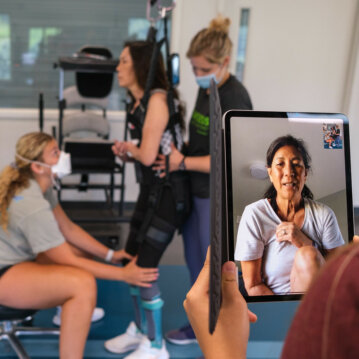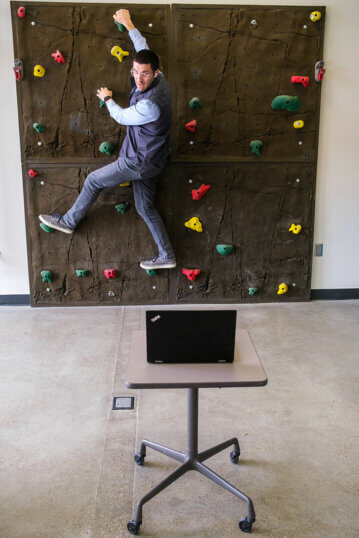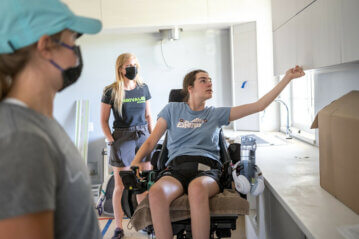We are living in an on-demand world and the conveniences we enjoy are evolving. A myriad of services are piped into our home. The powers of telecommunication allow us to work remotely. Easy-to-use apps deliver groceries to our doorstep. The world is coming to us.
When we look to our surrounding communities, we see new developments taking hold.
In Omaha alone, these infrastructural changes take on many forms, such as curb management sensors in the downtown and midtown areas, scooter pilot programs from 2019-2021, and an integrated payment application for city transportation. With each development, barriers are removed and needs are filled.
Any business, regardless of the field and outlook, must continually reinvent itself in order to stay not only relevant but ahead of the curve. Injury rehabilitation is no different. Programs from all around the world recognize this as key to successful client recovery. The aim is to provide clients with a place that will maximize their recovery potential through interpersonal connection, expertise, and evolving technology.
However, access to many of these resources is limited the day these clients leave the program doors. 
Thankfully, video and chat devices now open up a world of options never before available to them, offering progress via a digital realm.
QLI has been a proud pioneer of this evolution with the creation of Kintinu Telerehab, which focuses on delivering our proprietary and holistic approach to rehabilitation to clients across the country. Quite simply, clients can access supplemented therapies and neurological expertise with just the click of a button from anywhere in the United States.
After a brain or spinal cord injury, a person may discharge home before receiving a full continuum of care, perhaps because of the nature of their injury being less severe or due to a lack of funds provided by insurance. This drop-off in services can lead to a decline in the gains made through initial hospital stays or acute rehabilitation. Kintinu bridges these gaps by helping those who graduated QLI’s rehabilitation program, as well as others who did not, such as those with mild concussive injuries. Rehabilitation is delivered not in a hypothetical clinical setting, but from the client’s home. This is the optimal space to provide truly functional rehabilitation – with the environment and barriers that the client experiences.
Kintinu’s development predated the pandemic, being founded in 2018, putting QLI far ahead of the curve when it came to merging technological developments with therapies. The company was tested and tried, and was able to immediately provide access to programs for individuals when in-person therapies were
*****************
“Where do we see QLI in 50 years?” Fresh off QLI’s 30th anniversary, this question was posed in 2020 to team members across the company. Imagining this distant future was an exciting and welcoming challenge to physical therapist Anna Calgaard.
“We all work incredibly hard to offer every client every opportunity, every technological development blended in an individualized program geared toward their goals. But despite our best efforts, that same level of expertise may not always translate to their next environment.”
QLI’s commitment to reimagined technology manifested in the newly developed smart apartments, built in partnership with Holland Basham Architects and AOI.
The smart apartments are a bridged pilot program, with the goal being to observe how living in a tech-oriented environment might further aid someone post-injury.
“The term ‘smart apartment’ is one that extends beyond technology. It implements vision into every aspect of the space,” says Scott Meyers, QLI’s Chief Technology Officer. “The apartments are entirely malleable to meet the needs of clients. Everything, from appliances, to doors and windows, and air conditioning, runs through a controller, such as a tablet or smartphone. Settings can be altered for each client and voice activation is incorporated into almost every feature. Sinks and countertops can be raised or lowered, walls can be moved. This removes as many barriers as possible for an individual with physical limitations to live with the minimal amount of support and reduces the burden for families, friends, and caregivers.”
These smart apartments further what is possible in the realm of health care in the home. Part of this future is in an artificial intelligence management system that can perform analysis on the user. The 
Robots—something that still seems fixed in the world of science fiction, will also be a part of the smart apartments, allowing clinicians to check in with clients remotely through a screen housed in the robot itself.
“Ultimately,” notes Calgaard, “we want to ensure these environments are truly beneficial and sustainable for clients. With each individual that participates in the program, we have a unique opportunity to explore how that person interacts with the smart environment, and the benefit to be taken from it. My hope is to garner attention from facilities around the country. It would be wonderful to see apartments like these become the norm for individuals post-recovery everywhere.”
The smart apartments’ development represents the best of QLI, unlike anything else seen in the United States. It is a fusion of expertise and vision—all driven by a commitment to lead the rehabilitation field in what is possible.
As developments continue to integrate and strengthen the capabilities of communities, so too does the meter of expectations. On the horizon, there lies a dream of a community of these smart apartments—a place for individuals with physical limitations to have a home environment where they can thrive, unencumbered by their environment. As the smart apartment program develops, the dialogue continues with major tech companies and the City of Omaha with the shared vision of leading the country as a more accessible community. One where accessible transportation systems are ubiquitous and new technological developments expand services beyond what is currently available and instead focus on what is possible.
Categories: Kintinu, Reimagined Tech, Smart Apartments, Telerehab
